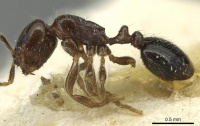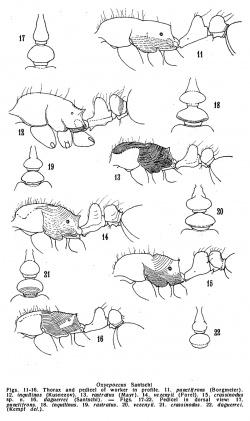Oxyepoecus daguerrei
| Oxyepoecus daguerrei | |
|---|---|

| |
| Conservation status | |
| Scientific classification | |
| Kingdom: | Animalia |
| Phylum: | Arthropoda |
| Class: | Insecta |
| Order: | Hymenoptera |
| Family: | Formicidae |
| Subfamily: | Myrmicinae |
| Tribe: | Solenopsidini |
| Genus: | Oxyepoecus |
| Species: | O. daguerrei |
| Binomial name | |
| Oxyepoecus daguerrei (Santschi, 1933) | |
Nothing is known about the biology of this species.
Identification
The exclusive character of O. daguerrei workers in relation to all other species in the genus is the straight costulae on the frontal carinae that prolong caudad, attaining the vertexal margin but failing to laterally reach the compound eye, also the postpetiole (d.v.) is relatively narrower than of others species of the genus (Albuquerque and Brandão 2009).
Keys including this Species
Distribution
Only known from three type specimens from Buenas Aires Province, Argentina.
Latitudinal Distribution Pattern
Latitudinal Range: -35.95° to -35.95°.
| North Temperate |
North Subtropical |
Tropical | South Subtropical |
South Temperate |
- Source: AntMaps
Distribution based on Regional Taxon Lists
Neotropical Region: Argentina (type locality).
Distribution based on AntMaps
Distribution based on AntWeb specimens
Check data from AntWeb
Countries Occupied
| Number of countries occupied by this species based on AntWiki Regional Taxon Lists. In general, fewer countries occupied indicates a narrower range, while more countries indicates a more widespread species. |

|
Estimated Abundance
| Relative abundance based on number of AntMaps records per species (this species within the purple bar). Fewer records (to the left) indicates a less abundant/encountered species while more records (to the right) indicates more abundant/encountered species. |

|
Biology
Only three specimens of O. daguerrei have been collected and all are from the same locality in Argentina.
|
Castes
Queens and males have not been collected.
Nomenclature
The following information is derived from Barry Bolton's Online Catalogue of the Ants of the World.
- daguerrei. Martia daguerrei Santschi, 1933e: 111 (w.) ARGENTINA. Combination in Oxyepoecus: Ettershank, 1966: 146. See also: Kempf, 1974b: 486; Albuquerque & Brandão, 2009: 294.
Unless otherwise noted the text for the remainder of this section is reported from the publication that includes the original description.
Kempf (1974) - O. daguerrei differs from Oxyepoecus crassinodus in the sculpture of the cephalic dorsum where the costulae attain posteriorly the occiput and are not separated into two patches by a median smooth stripe; the larger eyes with over 20 ommatidia in all and about 8 in a row across the greatest diameter; the more gently impressed metanotal groove; the rather inconspicuous propodeal armature, the teeth being rectangular and not obliquely raised upward when seen in profile; the weakly marginate and ecarinate lateral borders of declivous face of propodeum; the more compressed petiolar node.
The differences from Oxyepoecus rastratus are as follows: Sculpture on cephalic disc not attaining laterally the upper orbit of eyes which is separated from the sculptured area by a smooth stripe; shoulders scarcely marked; pronotum nearly continuously rounded in both directions; promesonotal disc smooth and shining; petiolar node not expanded laterad, decidedly narrower than postpetiole; the latter with weak transverse costulae on posterior surface of node.
Description
Worker
Kempf (1974) - (lectotype). Total length 2.6 mm; head length 0.63 mm; head width 0.52 mm; scape length 0.40 mm; maximum diameter of eyes 0.12 mm; Weber's length of thorax 0.72 mm; maximum width. of pronotum 0.36 mm; hind femur length 0.45 mm; petiole width.0.17 mm; postpetiole.width 0.23 mm; cephalic index 83. Fuscous brown to black; antennal scapes, thorax and pedicelar segments a bit lighter;
mandibles and legs reddish brown. Mandibles, scapes, sides and gular face of head, pronotum, part of mesonotum, legs, petiole and most of the postpetiole, gaster smooth and shining throughout. Front and vertex densely longitudinally costate-striate, but the sculpture does not attain laterally the upper margin of the eyes, yet attains posteriorly the occipital border when head is seen in full-face view; costulae gently diverging caudad, the lateralmost costulae attaining the occipital corner; strong piligerous punctures both on sculptured and smooth parts of the cephalic dorsum. Mesonotum laterally longitudinally costulate, discally smooth except for a few weak and extremely short costulae arising from the metanotal groove. Propodeum densely and finely transversely striato-costulate. Meso- and metapleura horizontally costulate, the intervals practically smooth. Abundant erect or suberect hairs of variable length on thorax, pedicelar segments and gaster; on head, except for the long clypeal hairs, they are shorter, inclined mesad dorsally on disc, forward on sides. Scapes and legs with short, inclined to subappressed hairs.
Head a little elongate, the sides in full-face view very gently convex, the occipital corners rounded, the occiput straight. Mandibles subtriangular, the basal border not longer than the chewing border, the basal tooth strong, separated from the subbasal tooth by a deeply concave excision, the diastema rather broad. Median apron of clypeus projecting forward over the mandibles, clypeal carinae strong, slightly diverging cephalad, forming a pointed tooth which is flanked laterally and below by another small denticle. Frontal area smooth, scarcely impressed, ill-separated from the clypeus. Frontal carinae very short, closely approximated, the distance between their outer edges (interfrontal width) distinctly less than one third of head width, subparallel in front, slightly diverging behind, terminating at level of anterior orbit of eyes. Cheeks feebly costulate, costulae not attaining eyes. Eyes relatively larger, with about 8-9 facets in a row across the greatest diameter, and a total of nearly 30 ommatidia. Distance between anterior orbit of eyes and mandibular insertion subequal to maximum diameter of eyes. Antennal scape failing to attain the occipital corner by a distance equalling its maximum width. Funicular segment I longer than VIII and IX taken individually, as long as II-V combined; segments II-VII broader than long, VIII and IX as long as broad, subequal in length.
Thorax without marked shoulders, the pronotum gently convex in both directions, anteriorly and laterally immarginate; shoulders not marked. Metanotal groove very gently impressed but distinguishable in profile. Basal face of propodeum nearly twice as long as broad, the sides submarginate, slightly divergent caudad, posterior corners dentate, the propodeal teeth rectangular in profile. Declivous face of propodeum laterally marginate yet not carinate.
Petiole strongly pedunculate, subpetiolar tooth well developed, node high, antero-posteriorly compressed yet not strongly expanded laterad, not forming in dorsal aspect a broad scale. Postpetiole lower but much broader than petiole due to the laterally projecting blunt cones, the posterior surface with feeble transverse costulae.
Type Material
Kempf (1974) - Three workers, taken at Rosas, F.C. Sur, Buenos Aires province, Argentina, by Juan B. Daguerre, nn.. 1904 and 666. One worker (n. 1904, lectotype) seen, received from the Borgmeier collection (TB). The workers of collection n. 1904 were originally mounted on the same pin with Solenopsis metanotalis var. picturata Santschi, and the single worker of collection n. 666 with Solenopsis tetracantha Emery, a fact which suggested to Santschi that they were taken together and living in a symbiotic relationship of some sorts.
References
- Albuquerque, N.L.d., Brandão, C.R.F. 2009. A revision of the Neotropical Solenopsidini ant genus Oxyepoecus Santschi, 1926 (Hymenoptera: Formicidae: Myrmicinae): 2. Final. Key for species and revision of the Rastratus species-group. Papéis Avulsos de Zoologia (São Paulo). 49: 289-309 (doi:10.1590/S0031-10492009002300001).
- Ettershank, G. 1966. A generic revision of the world Myrmicinae related to Solenopsis and Pheidologeton (Hymenoptera: Formicidae). Aust. J. Zool. 14: 73-171 (page 146, Combination in Oxyepoecus)
- Kempf, W. W. 1974b. A review of the Neotropical ant genus Oxyepoecus Santschi (Hymenoptera: Formicidae). Stud. Entomol. 17: 471-512 (page 478, see also)
- Santschi, F. 1933f. Fourmis de la République Argentine en particulier du territoire de Misiones. An. Soc. Cient. Argent. 116: 105-124 (page 111, worker described)




